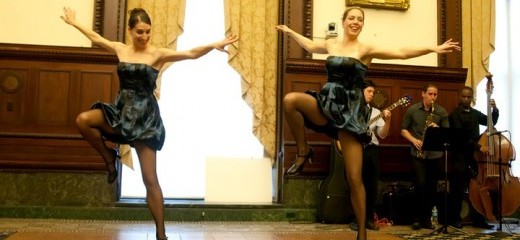
Photo: Brian Mengini
Time Travel With a Smile
By Debbie Shapiro
“No one has ever mistaken Savion Glover for Fred Astaire, and therein lies his appeal,” writes Roslyn Sulcas for the
New York Times in 2007. Although written five years ago, this line came back to me last week when viewing a performance of the Lady Hoofers as part of
City Hall Presents. The new series, organized by Philadelphia’s Office of Arts, Culture, and the Creative Economy, invites local performing arts groups to apply in order to be
featured. Although the selection process remains opaque, “inspiring citizens to become more active participants in the city’s arts and cultural offerings” by offering free events like this one is a mission I salute. On April 18
th the Lady Hoofers, who, according to their website, seek to “bring the art of rhythm tap back into the spotlight,” landed a spot on City Hall’s roster and presented an hour-long program to a very full room of spectators.
The lovely Kat Richter and Pamela Hetherington make a point of performing with live jazz accompaniment, and this evening was no exception—despite the awkward context of the Mayor’s Reception Room. To music by the Jon Katz quartet, the ladies perform both choreographed and improvised work; however, unlike celebrity hoofer Savion Glover, who strives to move toward a new era for tap through cross-disciplinary experiments, this program is dedicated to the retro, romanticized, Fred Astaire time.
For me, the term “hoofer” evokes a legacy of dance dominated by African American men. Unlike other tap styles based on body shapes and lines, hoofing is associated with baggy clothes, and with feet that remain close to the ground, producing an unbelievable number of unique sounds through subtle movements. It’s not that there haven’t been women brilliantly practicing the form for years (and white men too), it’s just that winning a battle of rhythm and being a “lady” (in the 1940s—for the sake of this argument) are two different things. It’s true, though, that tap’s evolution throughout history has included both the
glamorous and the
raw. The leading Lady Hoofers are surely a product of the former.
Richter wears a perfect, pageant-like smile and gracefully extends her arms in much of her choreography, while Hetherington looks at home in her high-heeled tap shoes and back-seamed stockings commanding equal attention. The group, a slightly nervous collection on a slippery floor, also features Katie Delhagen, Becky Mastin, and two classes of young students (elementary through high school ages). They dance through their repertoire under the sterile conference-room lighting of the colonial ballroom. Since the performers see us as clearly as we see them, they are distracted, and listening for the groove where one’s taps match up to the music becomes even more of a challenge than usual for the dancers. Some of the sequences, which (I bet) are normally a blast to perform, this evening come across more like tasks on a to-do list. I have plenty of time to notice the painted portraits depicting each and every mayor of Philadelphia, some black and some white, in the course of the multiple costume changes, silences padding transitions, and musical interludes provided by the live quartet.
One duet performed in mini, blue cocktail dresses to “It Don’t Mean A Thing” begins with a false start, and Hetherington counts off the band a second time to sync up musicians and dancers. Her improvised solo follows, and I find relief in seeing her close her eyes, find the beat, and breathe. “Cute,” a duet performed by Delhagen and Mastin, is stripped down to skill, demonstrating a wider range of rhythmic vocabulary. This pair wears a nonchalant demeanor and taps with all sides of their feet to make sound. Hoofers. Ladies. Indeed.
Since each of these dancers possesses a different strength, it’s easier to appreciate their talents in their solo work. Additionally, when I’m not evaluating the Lady Hoofers according to my associations with the name (and my aspirations for women to update the form as famously as men did), I find it hard not to smile, admiring four classy, hard-working gals, preserving and propagating an important piece of culture. They are available to dance at private events and to give workshops and lecture-demonstrations; the four teach tap to people of all ages throughout the region.
By Debbie Shapiro
April 30, 2012

